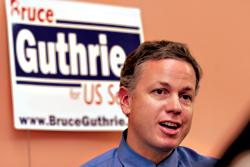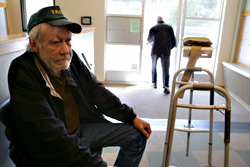As esoteric as planning-code revisions can seem, one thing is clear about proposed changes to downtown building heights: City Council member Peter Steinbrueck, chair of the council’s Urban Development and Planning Committee, and powerful real-estate developers are heading for a high-noon showdown over competing visions. At stake is how much affordable housing developers should subsidize for the right to build high—and it’s quarter of noon. This is the only shot the council will have to influence how many lower-income people get to live in planned downtown residential towers that otherwise will be filled with million-dollar-plus condos—whether downtown and the Denny Triangle area just to the north will become an inner-city Medina.
The fracas started quietly in December when Steinbrueck, who controls the shape of code revisions expected to hit the full council in the spring, proposed that developers pay $20 per square foot into a fund for affordable housing known as a bonus program. That would double Mayor Greg Nickels’ earlier proposal that developers be charged $10 per square foot, an amount that was crafted by developers themselves in a tightly controlled process and rubber-stamped by the mayor.
“Who is setting public policy here?” Steinbrueck said recently. He asked because on Jan. 9, the Housing Development Consortium, a collection of for-profit and nonprofit developers, sent the City Council a stern letter stating that $10 was their bottom line. They threatened “potential challenges” to the bonus program should they not get their way. And Nickels’ office is making similar noises. Says Tim Ceis, the deputy mayor: “We want to stick with the $10 fee.”
HDC’s letter bore the signatures of three of the biggest for-profit developers in Seattle: Greg Smith, William Justen of the Samis Foundation, and Richard Stevenson of Clise Properties. To some observers, the letter suggests an unholy alliance between those who build expensive condo towers and nonprofit developers who build affordable housing. The three big developers would like to break ground pronto on projects downtown but cannot, except at current lower heights of 240 feet, until the council passes a revised code. The revision is expected to allow developers to build residential towers up to 400 feet (see “Time to Grow Up,” Aug. 10, 2005).
The risk, say developers and their allies, is that a too-high fee will be a disincentive for developers, who will then build less and, as a result, contribute less money into the fund intended to create below-market-rate housing for low-paid service employees. The mayor’s office says a $10 fee will generate $100 million over 20 years. Steinbrueck’s proposal would create a fund of $200 million. Says Sarah Lewontin, executive director of the nonprofit Housing Resources Group: “The potential delays involved with a higher fee are going to put us in a position where we won’t see significant development resulting in affordable housing.”
Steinbrueck says he will stand firm on the $20 fee, especially since, he says, no developers will offer financial data of their own to justify their claims. What’s more, he says, last year’s process that produced the $10 fee was a closed affair. Multiple sources with knowledge of the meetings’ participants say that attendance was heavily weighted toward reps of for-profit developers like Clise, Smith, and Samis, as well as their lawyers and lobbyists. A list of attendees from the mayor’s office confirms this.
“I would disagree with that characterization,” says Sung Yang, a policy analyst for the mayor. Yang says, however, that the fee was decided “based on their discussion,” referring to the developers.
Nonprofit developers say they are frustrated by Steinbrueck’s assertions about the process and the implication that they were co-opted by the big developers. “Our honor is being impuned,” says Carla Okigwe, executive director of HDC, who also signed the Jan. 9 letter. “I’m annoyed that he’s calling it backroom deals.”
Honor aside, sources in the nonprofit development community are baffled that some nonprofit developers are going along with for-profit developers, when they should push for as much funding as they can get.
As contentious as matters seem, Ceis characterizes it as the City Council’s traditional role as dissenter. He says that nothing in any of Steinbrueck’s many proposed amendments to the Nickels-favored code changes upsets the mayor’s vision of tens of thousands of housing units in and near the city’s core. In Nickels-land, that’s called “validating the vision.”
As much as developers hint that a higher housing fee could produce a lawsuit, Steinbreuck remains unfazed. “If they don’t like paying the higher fee, the alternative is not to give them the additional height,” he says.
Steinbrueck’s committee is expected to complete its proposals by the end of March, with a full council vote to come later in the spring.







